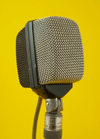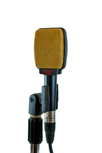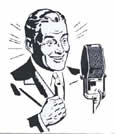 |
The AKG D 12 is a superb microphone, but its great sound can degrade over time; often the lower frequencies are no longer correctly reproduced. The earlier versions often have an impedance of 60 Ohms, later D 12s were mostly 200 Ohms. The lower impedance does not match modern mixing desks, resulting in less output and more noise, unless a step up transformer is used to match the signal.
A similar mic is no longer produced by AKG, but if you have to pay a steep amount for one, it makes sense to listen to it first, to judge the sound it produces. |
The less-known Echolette "Select Master" is often a lot less expensive, but essentially the same.
The Echolette Top 12 is different; it has the same capsule, but is smaller in size and lacks the special bass-chamber and thus has a less pronounced low end. |
 |
The AKG D 19's claim to fame is the fact that it was used as an overhead mic by The Beatles, in the Abbey Road studio. Although it has a useful vintage sound, the price is rocketing because Beatle-collectors pay high prices for them. This mic may also suffer loss of low end, plus the adjustable ring, to reduce low frequencies, may be broken, and the plastic resonator in the head often comes loose and causes a rattle. Finally this mic also comes in a 60 and a 200 Ohms version. The D 19 BK / Hi can be used both Hi and Low Z. |
Also produced for Philips, Revox, Siemens, Uher and Telefunken, but the price is often just as high. |
 |
The Beyerdynamic M 201 is a great mic, which is very sought after, but can it still be bought new for around 215 euro. Only 40 euros more than the usual 2nd hand price. Because soundwise there is no difference between old and new types, it makes sense to buy a new one. Apart from their great sound for snare and toms, it is good with guitar, percussion, trumpet and accordeon. |
Revox badged an OEM version as M 3500 (pictured here). These often sell for less than a hundred euros, which make them a very interesting buy. |
 |
The Beyerdynamic M 88 is another multi purpose mic; good on bass-drum, piano, horns, percussion and vocals. It was designed in the early Sixties, but remains in production (M 88 TG) and sounds the same. These days it costs 300 euro, used it is about a third less. |
De M 88 was also badged as Dynacord DD 800 (photo left) and Strasser M 800, these versions are often a lot less expensive |
 |
The Sennheiser MD 421 has come in different versions (even as MD 521 BF). In the modern MK 2 the high frequencies are raised. The older ivory coloured, and the black version from the end of the Seventies and later, basically sound the same, but differences caused by use and time may occur. Vintage fans prefer the old types.
The older versions had a metal stand-adapter, for the new ones it is made of plastic, but almost everyone hates all the adapters because the mics slip out of them often. |
The model was built with three different connectors (gross tuchel, tuchel en xlr), for the sound this is of no importance. Types without the low-cut filter may sound fatter. The gold & black version, specially aimed at entertainers, is extra scarce and expensive. |
 |
The MD 409 is considered the ultimate microphone to record electric guitar, but is equally good for snare and vocals. The price is often ridiculously high, especially in the U.S ($750). Although Sennheiser produced two modern varieties, these do not sound like the original and thus make a meager substitute. Time and time again it turns out that companies choose to turn out attractively priced models instead of quality. |
Also sold as Echolette ES 14 (see photo). The capsule was used in more microphones: the Sennheiser MD 403 and MD 407. Plus OEM as Dual, Fischer and Harting, these are often much cheaper. The MDS 1 (a.k.a. Grundig GDSM 200), MD 405 and MD 408 share the same capsule, but are contained in a round casing, resulting in a slightly different sound. |
 |
The Sennheiser MD 509 BF (Black Fire) is exactly the same as the MD 409. The Black Fire series were aimed at musicians, the other versions were meant for Pro Audio which had different distribution and sales channels. |
|


 Video's
Video's Contact
Contact







